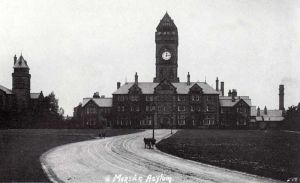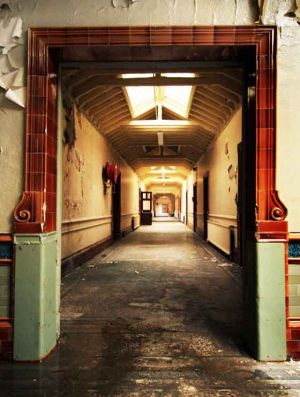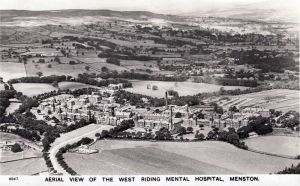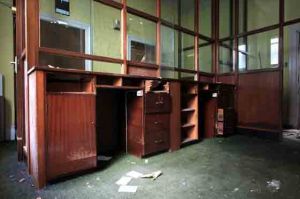REPORT OF COMMISSIONERS OF THE BOARD OF CONTROL.
West Riding Mental Hospital,
Menston,
9th April, 1930.
Since our Colleagues visit just six months ago the following numerical changes have taken place amongst the patients in this Hospital
……………………………………………………..Males females. Total.
Admitted……………………………………………64…….61……..125
Transferred to other care………………………2………-………….2
Discharged from reception…………………..40……..50……….90
of whom had recovered………………………28……..34……….62
of whom dealt with under s79……………..11……..15……….6 Allowed out on trial…………………………….26……..33………59
of whom granted allowances…………………9……….2………11
Died………………………………………………….34……..28………62
These changes leave on the books the names of 1,843 patients in the proportion of 897 males to 946 females. Two men and 4 women are now out on trial leaving1,837 in residence During the year ended 31st December last the average number of patients resident was 1,844, 889 males and 955 females.
The total accommodation as returned to us is for 875 patients by day and 857 by night on the male side, and for 900 by day, and 907 by night on the female side. There is therefore an. excess of 38 male and 42 female patients at the present time. Private patients number 136 men and 38 women, 115 of- the former sex being ” Service ” or ” ex-service patients. There are 4 of each sex out-county patients. The weekly maintenance charge is 23/4 for the Home patients and 28/- for those of the private class. The average maintenance cost as last ascertained was 23/4 per week.
To the best of our belief we have seen all-the patients in residence and given them an opportunity of talking.’ with us. The weather being wet and foggy, the patients were in the wards and notwithstanding this they were generally quiet and well behaved, and free from noisy excitement in those wards where the more unruly patients were. It struck us that a large number of both sexes were sitting about doing nothing, and we think that a more liberal supply of magazines, picture papers and such like would be a good thing, and especially in the wards where the lower type of patients were. Generally their dress, and personal appearance were satisfactory.
There still seems to be a shortage of overcoats, although we are informed the stock has been increased. On the male side there is a supply of footwear for indoors, but it seems there is none on the female side. Parole is allowed on the male side only, 19 men having it beyond the estate, and 53 within the grounds. One ward on either side is open to the grounds, and one ward on each side to the ward gardens only. The day rooms and galleries were tidy and well kept, and the dormitories and single rooms with their beds and bedding clean and in good condition. We were informed that screens were available for placing between the baths in the female bathrooms.
The return of the weekly average number of patients usefully employed is good, being 70-3 per cent. 72-7 for the men and 68-1 for the women. Besides the patients employed in the laundry, Kitchen, and other departments we saw some women engaged in raffia and such like handicraft in ward21. Anew Sewing room is being erected, and when this is finished the present room will be used as a study room for the female nursing staff. Completed since the last visit are the erection of a verandah to Ward 22 the female side of the Isolation Hospital, the provision of a continuous bath in the admission Wards on either side, and the alteration to the drying closets, and water supply in the Laundry.
The work of continuing the installation of Electric lighting is going on. We saw the dinner in preparation in two of the kitchens, and afterwards saw it being partaken of by about 460 male patients in their dining hall. It consisted of meat, potato and onion pie, followed by sago pudding. It was of good quality and well cooked. Since our colleagues’ visit six months ago the general health of the patients has been good, and with the exception of a few cases of influenza of mild type, and 4 cases of erysipelas there has been no occurrence of any disease of an epidemic or infectious nature. We are pleased to note that the hospital has been and is entirely free from dysentery or enteric fever, and that tuberculosis is represented to-day by 8 cases on the male side, and 6 on the female.
The mortality rate for the year ended 31st of December,
1929, was 9-33 per cent. for the males, and 7-95 per cent. for the females, or 8-62 per cent. for the combined sexes. Since last visit there have been 62 deaths (34 males and 28 females) all, with one exception, from natural causes. In the except.ed case, an epileptic died from asphyxia during a fit. This death and one other which the patient died from natural causes (degeneration of heart and arteries) were the subjects of Coroners inquests and the whole circumstances were communicated to our Board at the time. The principal causes of death, verified by post-mortem examination in 45 instances, were heart disease (11) arterio sclerosis (6), senile decay (5), general Paralysis (8) Organic brain disease (3), pneumonia (7), and tuberculosis (9). _
Four patients died of one or other form of cancer, and in the remainder death was due to a number of bodily diseases not requiring particular mention. Only two casualties involving fracture of bone have occurred, both of a minor character.
We are well satisfied that the patients under treatment in bed numbering 51 males and 66 females to-day, are kindly and efficiently nursed, and in receipt of skilled treatment on modern lines. Advantage is being taken of the new treatment centre its various departments, but we venture to suggest that fuller use might be made of ultra-violet therapy.
There has been no resort to mechanical restraint or seclusion.
During our tour of the wards we found on duty 66 male and 55 women nurses. Over five years’ service can be reckoned by 68.8 of the men, and 44.8 of the women, which is satisfactory. Sixty – five of the women nurses live outside the Institution.
Dr Edgerley has the assistance of Dr. R, Clive Walker. deputy Superintendent, and Drs. R.KKirwan, J. Russell, R. E. Hodgson, and D. Perk as Medical Officers.
A residence for an assistant medical officer has been completed, and is in occupation. Another similar house is just about to be commenced.
B T HODGSON, Commissioners
of the
R. CUNYNGHAM BROWN Board of Control.
Memoranda on Commissioners’ Report.
(1) Suggesttion that a more liberal supply of magazines, picture papers. be provided, especially in Wards where the lower type of patients are.
(2) Shortage of Overcoats.
(3) Provision of footwear for indoors on the female side.
(4) Suggestion that fuller use might be made of ultra-violettherapy.
All content copyright protected.
.jpg)









